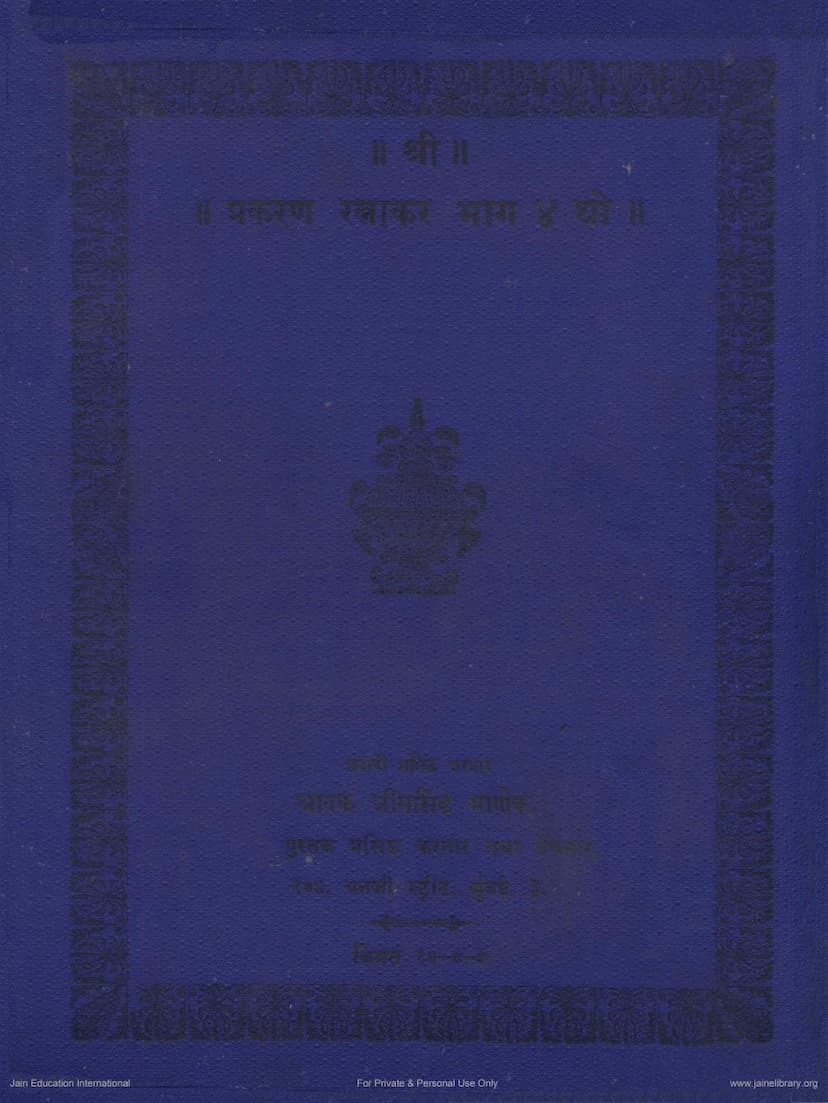Prakarana Ratnakar Part 4
Added to library: September 2, 2025

Summary
The provided text is a Jain scripture, specifically the fourth part of "Prakarana Ratnakar" (प्रकरण रत्नाकर), authored by Bhimsinh Manek Shravak from Mumbai. The catalog link points to jainqq.org, indicating it's a Jain text.
Here's a comprehensive summary based on the provided pages, focusing on the introductory sections and the content outlined in the table of contents (अनुक्रमणिका):
Book Title: Prakarana Ratnakar Part 4 (प्रकरण रत्नाकर भाग ४) Author: Bhimsinh Manek Shravak, Mumbai (शा. नीमसिंद माणक) Publisher: Shravak Bhimsinh Manek (शा. नाणजी माया घर नंबर २२४-२३१ शाक गल्ली, मांडवी, मुंबई) Publication Year: 1912 (शके १८३४ संवत् १९६८ अशाड शुदि २ सने १९१२)
Overall Purpose and Content:
This part of "Prakarana Ratnakar" is presented as a collection of various topics related to Jain scriptures, aimed at increasing knowledge. It explicitly states that this volume is designed to be enjoyable and informative for individuals of all intellectual capacities, from those with subtle to gross intelligence.
Key Texts Included:
The preface highlights the inclusion of several important Jain texts, meticulously compiled with commentaries (बालावबोध सहित) for easier understanding:
-
Sanghayani Ratna (संघयणी रत्न): Also known as "Trailokya Deepika" (त्रैलोक्यदीपिकाख्य ग्रंथ). This text, presented with a detailed commentary, discusses the four types of beings (चातुर्गतिक जीव) and their lifespans, particularly focusing on celestial beings (देवगति). The text emphasizes the necessity of understanding this scripture for comprehending the nature of beings in different realms. The version included is the shorter one by Shrimad Acharya Samghayani, as the larger "Brihat Sanghayani" by Shrimad Jinaghamganikshama Shraman is less commonly known.
-
Kshetra Samas (क्षेत्रसमास): This text, also provided with a commentary, is for those interested in sutra-based knowledge. It details the measurements and characteristics of various geographical elements on Jambudvipa (जंबुद्धीप), such as kulgiri (कुलगिरि), rivers, mountains, peaks, and other eternal substances that are the abode of humans and other beings. The preface stresses the importance of this knowledge for those following the Jain faith, comparing its absence to a significant oversight.
-
Shatkarma Granth (षट्कर्मग्रंथ): This text is considered highly important because understanding it is crucial for grasping the nature of karma and life itself. It explains how knowledge or ignorance of karma leads to different outcomes. The text aims to guide individuals towards liberation (सिद्धत्वपद) by understanding the true nature of karma and achieving its destruction (कर्मनिर्जरा). It meticulously details:
- The definition of karma.
- The number and types of root karma (मूल प्रकृति).
- The number and types of derived karma (उत्तर प्रकृति).
- The names and forms of these karmas.
- How souls become bound to karmic natures like Mohaniya (मोहनीय) and how they are shed (उडीरणा).
Emphasis on Accessibility:
A significant aspect of this compilation is the effort to make complex Jain philosophical and cosmological concepts accessible. The preface repeatedly mentions the inclusion of "Balavabodh" (बालावबोध), which translates to "easy explanation for children" or a simplified commentary, making these texts understandable even for those with less advanced intellectual or scriptural background. The compiler acknowledges that these texts contain profound meanings (अतिसूक्ष्मार्थनी वातो) and highlights the efforts of the commentators (पंडितवर्यो) in making them clear.
Addressing Potential Objections:
The preface also addresses potential criticisms regarding the size of the volume. It explains that the extensive commentary, especially for the Shatkarma Granth, was necessary to fully explain the subtle concepts and overcome the limitations of simpler previous commentaries. The inclusion of diagrams (यंत्रो) and charts (चित्रादिक) is also mentioned as crucial for proper understanding, although some could not be fully included due to the sheer volume of the commentaries.
Structure of the Volume:
The preface details the content's progression, starting with various hymns and stotras (स्तवन) dedicated to Jain Tirthankaras (like Rishabhdev, Parshvanath, Mahavir, Shantinath) and then moving into the more technical and cosmological texts like Sanghayani, Kshetra Samas, and Shatkarma Granth. The table of contents (अनुक्रमणिका) provides a detailed breakdown of each section and chapter, listing the specific stotras and the key topics covered within the major texts.
Key Themes:
- Knowledge Expansion (ज्ञानवृद्ध्यर्थे): The primary goal is to disseminate Jain knowledge.
- Accessibility: Making profound scriptures understandable through commentaries.
- Comprehensive Collection: Bringing together various important texts.
- Understanding Karma: A significant focus on the intricate details of karma.
- Cosmology and Geography: Explaining the structure of the Jain universe, particularly Jambudvipa.
- Spiritual Path: Guiding individuals towards the path of liberation through correct understanding of dharma and karma.
Corrections and Errata (शुद्धिपत्रक):
The text includes a detailed "Shuddhipatraka" (शुद्धिपत्रक) or errata for the Shatkarma Granth. This section meticulously lists numerous corrections to specific verses and paragraphs, indicating a commitment to accuracy and refinement in the printed text. These corrections range from grammatical adjustments to clarifications of technical terms and factual details within the complex descriptions of karma.
In essence, Prakarana Ratnakar Part 4, as presented here, is a scholarly and devotional compilation aimed at providing a comprehensive and accessible understanding of key Jain scriptures related to cosmology, geography, and the intricate science of karma, making it a valuable resource for Jain learners.